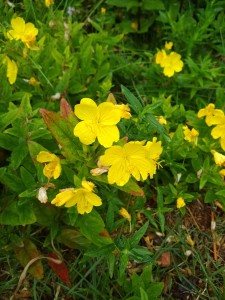 Summer is here and the color dynamic in my front garden has changed. One month ago, purple and white held sway, with the explosion of Siberian iris and the even bigger explosion of tradescantia or spiderwort. Now they have faded away, soon to be cut back. I would allow my army of garden minions to do this job, but unfortunately the minions exist only in my imagination. I am in the process of doing it myself.
Summer is here and the color dynamic in my front garden has changed. One month ago, purple and white held sway, with the explosion of Siberian iris and the even bigger explosion of tradescantia or spiderwort. Now they have faded away, soon to be cut back. I would allow my army of garden minions to do this job, but unfortunately the minions exist only in my imagination. I am in the process of doing it myself.
As I ply the clippers, the yellow-flowered plants are coming into their own, preceded by a white fanfare, as the semi-double Shasta daisies start opening, along with a few ‘White Swan’ coneflowers. Yellow has announced itself in the form of small-flowered Coreopsis ‘Zagreb’, which is actually closer to gold than yellow. It has a delicate glamour and lovely, fern-like foliage.
“Delicate” is not the word I would use to describe sundrops, or yellow-flowered Oenothera. The flowers look like giant buttercups, with four petals apiece, blooming atop stems that may be up to two-feet tall. They are open in the morning when I unlock the front door, but are closed by late afternoon.
The individual who gave me my first sundrop plant referred to it as a “four o’clock”, because that is about the time the flowers fold their petals for the day. Since then, I have learned that the same name is more often used to describe an annual, Mirabilis japonica, an unrelated plant that sports flowers in a variety of showy colors. Mirabilis japonica blooms open about the time my oenothera calls it a day, justifying the common name.
In the plant world descriptive common names are sometimes applied to more than one plant, which is why Latin names are so helpful.
To add a bit more confusion to an already confusing tale of common and not-so-common plant names, plants in the Oenothera genus are collectively known as “evening primroses”, and sundrops are often described as “day-flowering evening primroses”. Trying to understand all that is too taxing for the brain and detracts from the fact that sundrops are simply beautiful. Since I generally fold my petals at night, I appreciate the fact that the flowers are open when I can see them.
Whatever you call them, sundrops are most alluring when they are blooming. The soft green leaves can be up to three inches long and lance-shaped. They are decent looking when the flowers have finished, but do not make a loud statement. Shearing the plants back after bloom time will give you a tidy green mound that serves the practical purpose of protecting garden space that might otherwise be occupied by voracious summer weeds.
Oenothera is part of the large Onagraceae plant family, which also encompasses the popular gaura—also known as beeblossom or wandflower—and clarkia, a western wildflower named after explorer William Clark of Lewis and Clark fame.
Oenothera is also native to North America. The fruticosa species grows wild in the eastern United States. It has long been a stalwart of traditional flower gardens, but has also been hybridized to produce larger yellow flowers. ‘Fyrverkeri’, sometimes sold as ‘Fireworks’, is one fruticosa variety that sports reddish stems and leaf edges on a plant that grows only 18 inches tall. ‘Summer Solstice’ is a similar variety that also bears large yellow flowers accented by the reddish tints of buds, stems and leaf edges. For something a little different, try ‘Rosea’ or ‘Siskiyou Pink’, with flowers in shades of pale pink and deeper rose respectively.
Since my sundrops were “passalong plants”, I have no idea of their varietal name. I do know that they love my garden, with its somewhat lean soil. The first plant has long since given birth to scores of offspring, which means that I have several healthy clumps scattered over my front garden and another in the back. The deer seem to ignore them, preferring to gobble lily buds and hosta leaves. I am grateful that sundrops do not need precious drops of DeerOff.
This vigor upsets some people, but the plants are also easy to uproot, so I don’t regard it as a problem. Sundrops probably won’t work in a formal planting scheme, but look great elsewhere. If you are a container gardener, grow them in lightweight pots that you can drop into decorative containers while the yellow flowers are strutting their stuff and remove to a sunny, but less prominent location thereafter.
Your best bet for obtaining sundrops now is probably trolling a well-stocked local garden center. Mail order vendors carry the plants, but spring stocks are generally sold out. If that is the case, order for fall planting. Try White Flower Farm, P.O. Box 50, Litchfield, Connecticut 06759; (800)-503-9624; www.whiteflowerfarm.com. Print catalog available.
